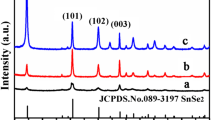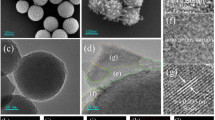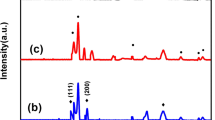Abstract
Rationally designed heterostructures provide attractive prospects for energy storage electrodes by combining different active materials with distinct electrochemical properties. Herein, through a phase separation strategy, a heterostructure of SnO2 encapsulated by amorphous Nb2O5 is spontaneously synthesized. Insertion-type anode Nb2O5 outer shell, playing as reaction containers and fast ionic pathways, physically inhibits the Sn atoms’ migration and enhances the reaction kinetics. Moreover, strong chemical interactions are found at the SnO2/Nb2O5 interfaces, which ensure the solid encapsulation of the SnO2 cores even after 500 cycles. When used for lithium-ion batteries, this heterostructured anode exhibits high cycling stability with a capacity of 626 mA h g−1 after 1000 cycles at 2 A g−1 (85% capacity retention) and good rate performance with the capacity of 340 mA h g−1 at 8 A g−1.

摘要
通过异质结构可以将不同电化学性质的电极材料人为地进行设 计组合实现优势互补, 这一方法为储能材料的未来发展提供了广阔前 景. 本文中, 我们通过一步自发相分离策略, 实现了SnO2包封于无定形 Nb2O5中的特殊异质结构. 嵌入型反应负极Nb2O5充当合金型负极SnO2 的反应容器和快速离子传输层, 空间上限制了Sn原子的迁移并增强了 反应动力学. 此外, 我们在SnO2/Nb2O5界面处发现了强化学相互作用, 使得Nb2O5封装层即使在500次充放电循环后仍能牢固包封在SnO2核 的表面. 这种异质结构材料作为锂离子电池负极表现出高循环稳定性, 在2 A g−1的大电流下循环1000次后容量为626 mA h g−1(容量保持率为 85%), 同时在8 A g−1的电流下容量仍可保持在339.9 mAh g−1, 展现出良 好的倍率性能.
Similar content being viewed by others
References
Etacheri V, Seisenbaeva GA, Caruthers J, et al. Ordered network of interconnected SnO2 nanoparticles for excellent lithium-ion storage. Adv Energy Mater, 2015, 5: 1401289
Park GD, Lee JK, Kang YC. Synthesis of uniquely structured SnO2 hollow nanoplates and their electrochemical properties for Li-ion storage. Adv Funct Mater, 2017, 27: 1603399
Song Z, Li H, Liu W, et al. Ultrafast and stable Li-(de)intercalation in a large single crystal H-Nb2O5 anode via optimizing the homogeneity of electron and ion transport. Adv Mater, 2020, 32: 2001001
Meng J, He Q, Xu L, et al. Identification of phase control of carbon-confined Nb2O5 nanoparticles toward high-performance lithium storage. Adv Energy Mater, 2019, 9: 1802695
Cheong JY, Kim C, Jung JW, et al. Formation of a surficial bifunctional nanolayer on Nb2O5 for ultrastable electrodes for lithium-ion battery. Small, 2017, 13: 1603610
Li Y, Zhang J, Chen Q, et al. Emerging of heterostructure materials in energy storage: A review. Adv Mater, 2021, 33: 2100855
Sheng N, Lu J, Hu J, et al. Synthesis of Sn@SnO2 core-shell microcapsules by a self-oxidation strategy for medium temperature thermal storage. Chem Eng J, 2021, 420: 129906
Zhang L, Zhao K, Sun C, et al. Compact Sn/SnO2 microspheres with gradient composition for high volumetric lithium storage. Energy Storage Mater, 2020, 25: 376–381
Zhu C, Xia X, Liu J, et al. TiO2 nanotube @ SnO2 nanoflake core-branch arrays for lithium-ion battery anode. Nano Energy, 2014, 4: 105–112
Huang S, Wang M, Jia P, et al. N-graphene motivated SnO2@SnS2 heterostructure quantum dots for high performance lithium/sodium storage. Energy Storage Mater, 2019, 20: 225–233
Cheng Y, Wang S, Zhou L, et al. SnO2 quantum dots: Rational design to achieve highly reversible conversion reaction and stable capacities for lithium and sodium storage. Small, 2020, 16: 2000681
Bhattacharya P, Lee JH, Kar KK, et al. Carambola-shaped SnO2 wrapped in carbon nanotube network for high volumetric capacity and improved rate and cycle stability of lithium ion battery. Chem Eng J, 2019, 369: 422–431
Gao C, Jiang Z, Wang P, et al. Optimized assembling of MOF/SnO2/graphene leads to superior anode for lithium ion batteries. Nano Energy, 2020, 74: 104868
An SJ, Li J, Daniel C, et al. The state of understanding of the lithium-ion-battery graphite solid electrolyte interphase (SEI) and its relationship to formation cycling. Curr Alzheimer Resbon, 2016, 105: 52–76
Lei Y, Han D, Dong J, et al. Unveiling the influence of electrode/electrolyte interface on the capacity fading for typical graphite-based potassium-ion batteries. Energy Storage Mater, 2020, 24: 319–328
Zheng Y, He YB, Qian K, et al. Deterioration of lithium iron phosphate/graphite power batteries under high-rate discharge cycling. Electrochim Acta, 2015, 176: 270–279
Luo W, Wang Y, Wang L, et al. Silicon/mesoporous carbon/crystalline TiO2 nanoparticles for highly stable lithium storage. ACS Nano, 2016, 10: 10524–10532
Wang X, Fan L, Gong D, et al. Core-shell Ge@graphene@TiO2 nanofibers as a high-capacity and cycle-stable anode for lithium and sodium ion battery. Adv Funct Mater, 2016, 26: 1104–1111
Yang J, Wang Y, Li W, et al. Amorphous TiO2 shells: A vital elastic buffering layer on silicon nanoparticles for high-performance and safe lithium storage. Adv Mater, 2017, 29: 1700523
Yi Z, Lin N, Xu T, et al. TiO2 coated Si/C interconnected microsphere with stable framework and interface for high-rate lithium storage. Chem Eng J, 2018, 347: 214–222
Chen D, Wang JH, Chou TF, et al. Unraveling the nature of anomalously fast energy storage in T-Nb2O5. J Am Chem Soc, 2017, 139: 7071–7081
Wang B, Zhao Y, Banis MN, et al. Atomic layer deposition of lithium © Science China Press and Springer-Verlag GmbH Germany, part of Springer Nature 2021 niobium oxides as potential solid-state electrolytes for lithium-ion batteries. ACS Appl Mater Interfaces, 2018, 10: 1654–1661
Heitjans P, Masoud M, Feldhoff A, et al. NMR and impedance studies of nanocrystalline and amorphous ion conductors: Lithium niobate as a model system. Faraday Discuss, 2007, 134: 67–82; discussion 103–118, 415–109
Xu J, Dong W, Song C, et al. Black rutile (Sn, Ti)O2 initializing electrochemically reversible Sn nanodots embedded in amorphous lithiated titania matrix for efficient lithium storage. J Mater Chem A, 2016, 4: 15698–15704
Gul E, Stanulis A, Barushka Y, et al. The influence of thermal processing on microstructure of sol-gel-derived SrSnO3 thin films. J Mater Sci, 2017, 52: 12624–12634
Narendar Y, Messing GL. Synthesis, decomposition and crystallization characteristics of peroxo-citrato-niobium: An aqueous niobium precursor. Chem Mater, 1997, 9: 580–587
Stanulis A, Hardy A, De Dobbelaere C, et al. SnO2 thin films from an aqueous citrato peroxo Sn(IV) precursor. J Sol-Gel Sci Technol, 2012, 62: 57–64
Sutter P, Wang J, Sutter E. Wrap-around core-shell heterostructures of layered crystals. Adv Mater, 2019, 31: 1902166
Pei J, Chen G, Zhang Q, et al. Phase separation derived core/shell structured Cu11V6O26/V2O5 microspheres: First synthesis and excellent lithium-ion anode performance with outstanding capacity self-restoration. Small, 2017, 13: 1603140
Xu YH, Wang JP. Direct gas-phase synthesis of heterostructured nanoparticles through phase separation and surface segregation. Adv Mater, 2008, 20: 994–999
Chen PC, Gao M, Yu S, et al. Revealing the phase separation behavior of thermodynamically immiscible elements in a nanoparticle. Nano Lett, 2021, 21: 6684–6689
Susarla S, Hachtel JA, Yang X, et al. Thermally induced 2D alloy-heterostructure transformation in quaternary alloys. Adv Mater, 2018, 30: 1804218
Graça MPF, Meireles A, Nico C, et al. Nb2O5 nanosize powders prepared by sol-gel-structure, morphology and dielectric properties. J Alloys Compd, 2013, 553: 177–182
Liu LZ, Li TH, Wu XL, et al. Identification of oxygen vacancy types from Raman spectra of SnO2 nanocrystals. J Raman Spectrosc, 2012, 43: 1423–1426
Zuo J, Xu C, Liu X, et al. Study of the Raman spectrum of nanometer SnO2. J Appl Phys, 1994, 75: 1835–1836
Ivanovskaya M, Ovodok E, Golovanov V. The nature of paramagnetic defects in tin (IV) oxide. Chem Phys, 2015, 457: 98–105
Li N, Niu X, Pei F, et al. Energy-level modulation in diboron-modified SnO2 for high-efficiency perovskite solar cells. Sol RRL, 2019, 4: 1900217
Xu Y, Zheng L, Yang C, et al. Oxygen vacancies enabled porous SnO2 thin films for highly sensitive detection of triethylamine at room temperature. ACS Appl Mater Interfaces, 2020, 12: 20704–20713
Jing Y, Wang Y, Furukawa S, et al. Towards the circular economy: Converting aromatic plastic waste back to arenes over a Ru/Nb2O5 catalyst. Angew Chem Int Ed, 2021, 60: 5527–5535
Jun JW, Suh YW, Suh DJ, et al. Strong metal-support interaction effect of Pt/Nb2O5 catalysts on aqueous phase hydrodeoxygenation of 1,6-hexanediol. Catal Today, 2018, 302: 108–114
Wachs I, Jehng J, Hardcastle F. The interaction of V2O5 and Nb2O5 with oxide surfaces. Solid State Ion, 1989, 32–33: 904–910
Wang Y, Aghamohammadi S, Li D, et al. Structure dependence of Nb2O5−x supported manganese oxide for catalytic oxidation of propane: Enhanced oxidation activity for MnOx on a low surface area Nb2O5−x. Appl Catal B-Environ, 2019, 244: 438–447
Yang P, Fan S, Chen Z, et al. Synthesis of Nb2O5 based solid superacid materials for catalytic combustion of chlorinated VOCs. Appl Catal B-Environ, 2018, 239: 114–124
Liu Y, Chen M, Su Z, et al. Direct trapping and rapid conversing of polysulfides via a multifunctional Nb2O5-CNT catalytic layer for high performance lithium-sulfur batteries. Curr Alzheimer Resbon, 2021, 172: 260–271
Luo D, Zhang Z, Li G, et al. Revealing the rapid electrocatalytic behavior of ultrafine amorphous defective Nb2O5−x nanocluster toward superior Li-S performance. ACS Nano, 2020, 14: 4849–4860
Dong C, Dong W, Zhang Q, et al. Sulfur-terminated tin oxides for durable, highly reversible storage of large-capacity lithium. J Mater Chem A, 2020, 8: 626–631
Dong W, Xu J, Wang C, et al. A robust and conductive black tin oxide nanostructure makes efficient lithium-ion batteries possible. Adv Mater, 2017, 29: 1700136
Wu M, Jin J, Wen Z. Influence of a surface modified Li anode on the electrochemical performance of Li-S batteries. RSC Adv, 2016, 6: 40270–40276
Yin M, Xu J, Li Q, et al. Highly active and stable Pt electrocatalysts promoted by antimony-doped SnO2 supports for oxygen reduction reactions. Appl Catal B-Environ, 2014, 144: 112–120
Dien LX, Truong QD, Murayama T, et al. Gold nanoparticles supported on Nb2O5 for low-temperature CO oxidation and as cathode materials for Li-ion batteries. Appl Catal A-Gen, 2020, 603: 117747
Zheng Y, Zhou T, Zhao X, et al. Atomic interface engineering and electric-field effect in ultrathin Bi2MoO6 nanosheets for superior lithium ion storage. Adv Mater, 2017, 29: 1700396
Li L, Zheng Y, Zhang S, et al. Recent progress on sodium ion batteries: Potential high-performance anodes. Energy Environ Sci, 2018, 11: 2310–2340
Zhang S, Fan Q, Liu Y, et al. Dehydration-triggered ionic channel engineering in potassium niobate for Li/K-ion storage. Adv Mater, 2020, 32: 2000380
Acknowledgements
This work was supported by China Postdoctoral Science Foundation (2020M671242 and 2021T140688), the Special Research Assistant program of CAS, and the Super Postdoctoral Fellow Program of Shanghai. We would also like to acknowledge the help from Dr. Muhammad Sohail Riazon on language and grammar during the article writing.
Author information
Authors and Affiliations
Contributions
Li R and Xu J designed and engineered the samples; Li R and Lv Z performed the experiments; Li R wrote the paper with support from Dong W and Huang F. All authors contributed to the general discussion.
Corresponding authors
Additional information
Conflict of interest
The authors declare that they have no conflict of interest.
Ruizhe Li is currently a PhD student at Shanghai Institute of Ceramics, Chinese Academy of Sciences (SICCAS) supervised by Prof. Fuqiang Huang and Guobao Li. He obtained his BSc degree from Hua-zhong University of Science and Technology in 2016. His research focuses on engineering conversion/alloying type multi-element transition metal oxides for lithium ion batteries.
Wujie Dong obtained his PhD degree under the supervision of Prof. Fuqiang Huang in 2019 from the College of Chemistry and Molecular Engineering, Peking University. He is a special research assistant of SICCAS. His-research interests include the high-performance lithium-ion batteries, supercapacitors, and electro/thermos-catalysis.
Fuqiang Huang received his PhD degree in chemistry from Beijing Normal University in 1996. From 1996 to 2003, he worked in the United States as a research staff member. Then he joined the State Key Lab of High Performance Ceramics & Superfine Microstructure, SICCAS, and became a full professor in 2003. His current research interests mainly focus on designing deficient oxide for secondary batteries and developing new functional compounds for energy storage, superconductors and electro-catalysis.
Supporting Information
Rights and permissions
About this article
Cite this article
Li, R., Xu, J., Lv, Z. et al. Achieving highly stable Sn-based anode by a stiff encapsulation heterostructure. Sci. China Mater. 65, 695–703 (2022). https://doi.org/10.1007/s40843-021-1783-0
Received:
Accepted:
Published:
Issue Date:
DOI: https://doi.org/10.1007/s40843-021-1783-0




